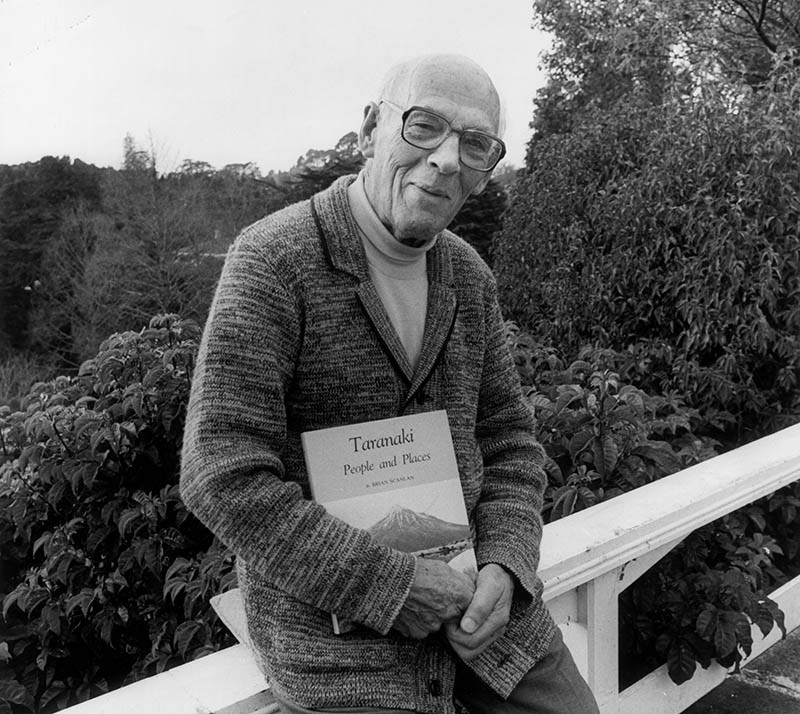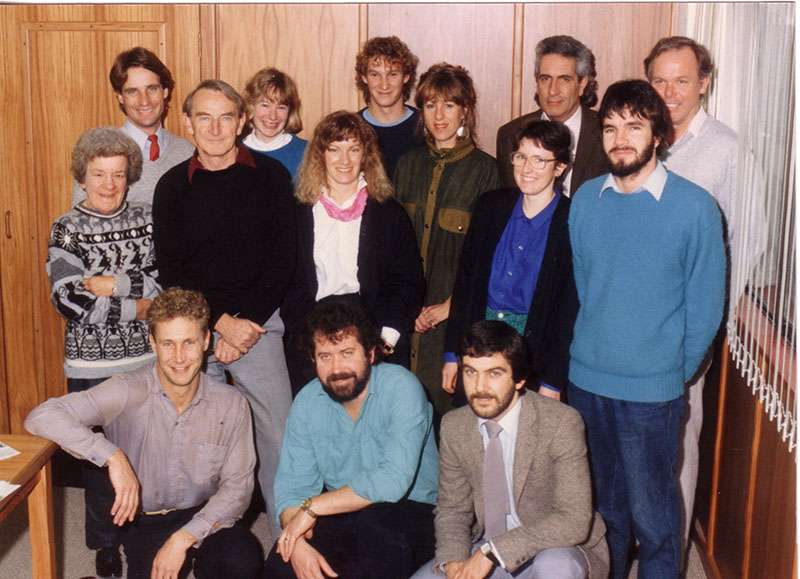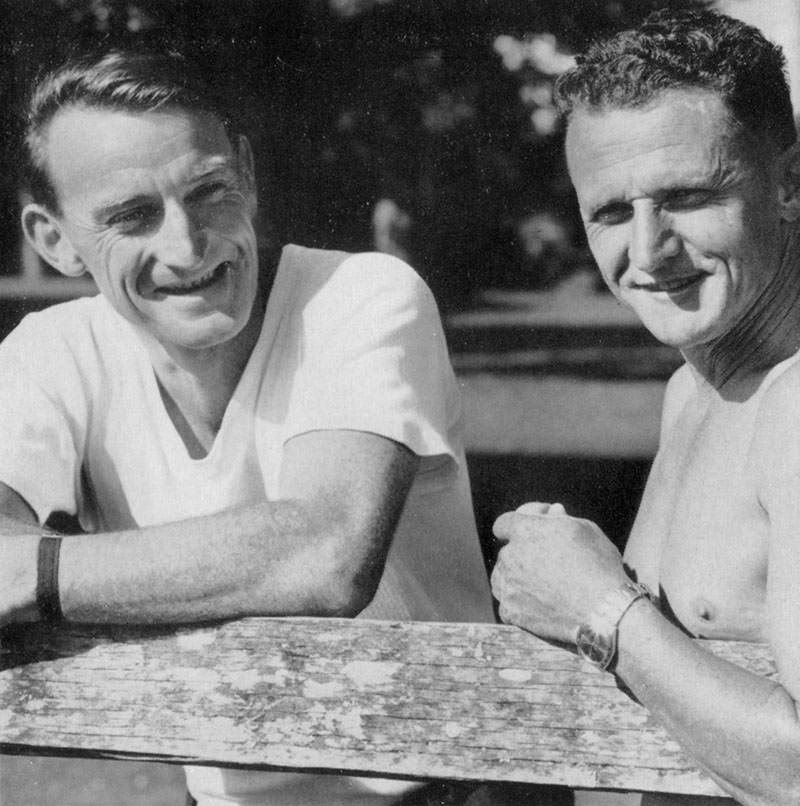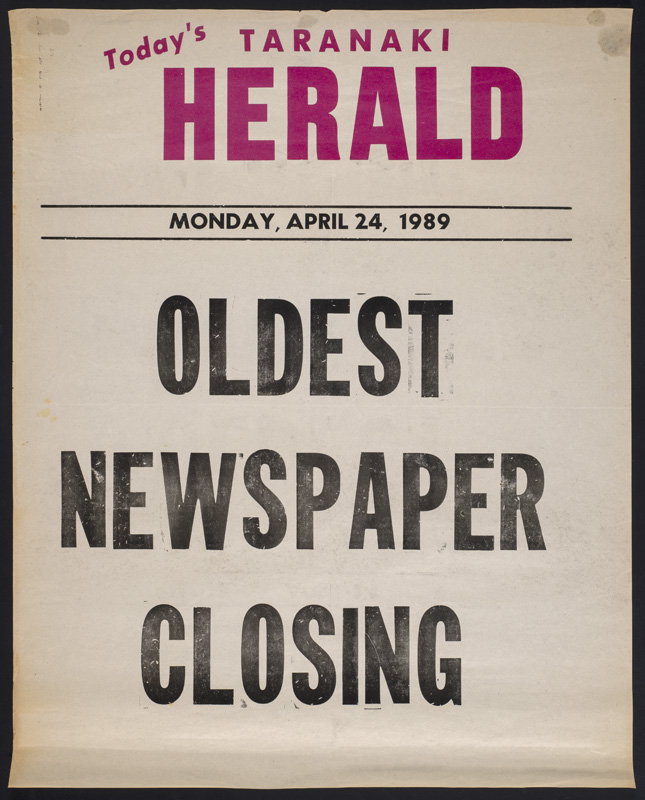






When Garth Gilmour sits down to write, he feels a ghostly presence at his back. The long-time journalist, who had lasting stints at the now-defunct Taranaki Herald, is forever mindful of lessons learnt from former editor, the late Brian Scanlan. "I constantly think of Brian and of the effect that he had on me about being meticulous about writing" says Gilmour.
Gilmour joined the Taranaki Herald in 1949 and was chief reporter from 1952 to 1957. He returned to the afternoon daily paper in 1975 as associate editor to the late George Koea. But it was the man reporters respectfully called Mr Scanlan who marked Gilmour for life.
"Brian for me was the best editor I worked for and I worked for a bunch" he says. One of those editors was Sir James Hutchinson of the Otago Daily Times. During Garth's time as a cadet journalist, glimpses of the editorial leader were as rare as moa sightings. "I didn't know he really existed because I never saw him. But Brian, you knew he existed. He was a great journalist and he had three loves - his newspaper, New Plymouth and his lovely mountain [Mount Taranaki]. There was a lot of controversy about a lot of things in those days”.
One of the big issues was the neglect of roading, with the main highway north unsealed and uncared for. "The newspaper was able to lead the way to change because at the time it had nearly total saturation - it went to 98% of households" Gilmour says. "And why? Because you never knew what it was going to say next - and that was because of Brian. The leader page in those days had to have three brand new, top-of-the-column stories and the other main news pages were also expected to carry new local leads. Since we had a staff of seven [reporters] what we were expected to do in getting new stories was a huge challenge."
As well as demanding, the boss was also a perfectionist. "Brian Scanlan was intolerant of inaccuracies and inclined to bursts of fury. Brian would go through the paper every night, word by word by word, and if he found an error he would come thundering up the stairs four at a time in a towering rage demanding explanations and, as his chief reporter, it was down to me. He would quiver with rage at times with serious blunders - and we had a few. He was known to hurl things. Once, one of his missiles [a pen] hit me. He had the grace to apologise."
These are lessons never forgotten. "Brian set a demanding standard and if you maintained it, you could do no wrong with him, although he did not over-praise. But he had a wonderful smile and it was nice to see it."
While Scanlan was tough on his journalists, he was also fiercely protective of their reporting rights. "He was as loyal to us as we were to him. I remember once some citizen came ripping up the stairs to complain that a reporter had not treated him very well. Brian listened to him for about 30 seconds then threw him out. He said, 'People can't come in and run my staff down'."
Scanlan continues to leave his mark in Taranaki - via history. The fastidious researcher wrote a number of books detailing stories, places and events of this region's past. He also trained another Taranaki newspaper legend, June Litman. She and Gilmour worked together a number of times through the years. "She came back from England while I was there. She was my left hand, right hand woman. She was a fantastic worker, a workaholic, like me" he says. "We were meant to do a five-and-a-half-day, 44-hour week, but mostly it was 80 hours a week, with no over-time in those days. But we did the hours because of Brian Scanlan."
Like Gilmour, the pedantic, chain-smoking Litman was possessively enthusiastic about the Taranaki Herald. "It was her entire life. It was quite obvious that whatever June Litman became, she would remain a journalist and a great sub-editor." Litman went on to become news-editor, the first woman to hold that position on a daily newspaper in New Zealand.
After she retired in 1986, Litman and Gilmour teamed up again, this time as the editorial trainers for the now-defunct New Zealand Newspapers chain. This was their third and last stretch working together and it was a meeting of like minds. Side by side they taught fresh crops of reporters and honed the skills of sub-editors by going back to the basics of grammar, brevity, spelling and getting things right.
Gilmour says three main rules reporters must always stick to are: Honesty, accuracy and caring for and respecting your sources. "That came from Scanlan to a large extent." The Litman-Gilmour teaching alliance lasted for about four years. On 9 April 1991, June died at the age of 65. But the Taranaki Herald went first, closing on 29 April 1989. At the time of its demise, it was the oldest daily newspaper in New Zealand.
Gilmour is a survivor and he's thriving.
He says he discovered the art of healthy living more than 40 years ago and has remained on the fitness trail ever since. "I gave up 80 cigarettes a day and the booze, and took up running." It all began with a fortuitous meeting with running guru Arthur Lydiard in 1960 after his three-medal coaching success at the Rome Olympics turned the international spotlight on his revolutionary training system.
One of the medals, the 800-metres gold, was won by Opunake-born Peter Snell, Murray Halberg won the 5000 metres and Barry Magee was third in the marathon. Gilmour went to talk to Lydiard about Rome for the Auckland Star but found the coach in a dilemma. He had a pile of letters from publishing companies wanting him to write a book about his training methods.
This is the conversation that followed:
Lydiard: "I can't write a book."
Gilmour: "Well, get someone to help you."
Lydiard: "Would you be interested?"
Gilmour was. "We started writing it that night."
Their book, Run to the Top, led Gilmour into training and further athletic writing. By then he was working full-time in public relations after a difference of opinion with his news-editor at the Star. In his spare time he managed to produce the Murray Halberg story, A Clean Pair of Heels, and train to run a marathon because Lydiard had told him, "Even you could." The extra work was crammed into the weekends and evenings. "I would often do my running at 1 or 2 in the morning. I survived for many months on three hours' sleep at night."
In 1965, Gilmour scored a rare double with his third book, No Bugles No Drums, with Peter Snell, and Run For Your Life, a training book on the new Lydiard-inspired jogging cult being launched on the same day. He has continued pouring out athletics books, mostly in conjunction with Lydiard. Several have been printed in other languages. "I'm just the other author for all these people. I cornered a nice wee market, all by accident" Gilmour says, referring to that timely meeting with Lydiard in 1960.
And the writing continues.
Gilmour is a living example of being energetic in the third age. "I have probably worked harder since I retired" he says, an easy grin appearing below his hooked nose. "I enjoy it. It's a great challenge and satisfying."
He has not made a fortune out of his career, but is unconcerned. Money has never been his driving force. "You write for what needs to be put in books. If it makes a fortune for the writer ... nice. If it doesn't, you are at least leaving something worthwhile behind."
On top of the writing, Gilmour is in training again. With six marathons and hundreds of miles' running training behind him, his knees gave up way before his will, so he became a cyclist. He has a bike on rollers for inside sessions and another newer one for road work.
At the end of November 2003, he entered the 16-kilometre Lake Taupo Cycle Challenge. "My old legs battled on in a head wind and at 100km I said 'stuff it'. Then I gave it away and finished it by bus - it was nice too. I hadn't done enough training for the hills, which were just horrendous. In the finish I was going on legs that were like jelly."
Not one to be beaten easily, Gilmour has his eye on the Taranaki Around the Mountain Challenge on 24 January. He also hasn't let Taupō out of his sights. "I might even have another whack next year." There will always be a goal ahead of Gilmour - a book to write, a race to enter, more living to do. "You should die knowing that you have not done all the things you want to do." He lives life like there are many more tomorrows.
Gilmour, G. (1965). Run for your life: Jogging with Arthur Lydiard. Auckland: Minerva.
Halberg, M. and Gilmour, G. (1963). A clean pair of heels: the Murray Halberg Story. Wellington: Reed.
Lydiard, A. and Gilmour, G. (1983). Jogging with Lydiard. Auckland: Hodder and Stoughton.
Lydiard, A. and Gilmour, G. (1962). Run to the Top. Wellington: Reed.
Snell, P. and Gilmour, G. (1965). No Bugles No Drums. Auckland: Minerva.
Please do not reproduce these images without permission from Puke Ariki.
Contact us for more information or you can order images online here.